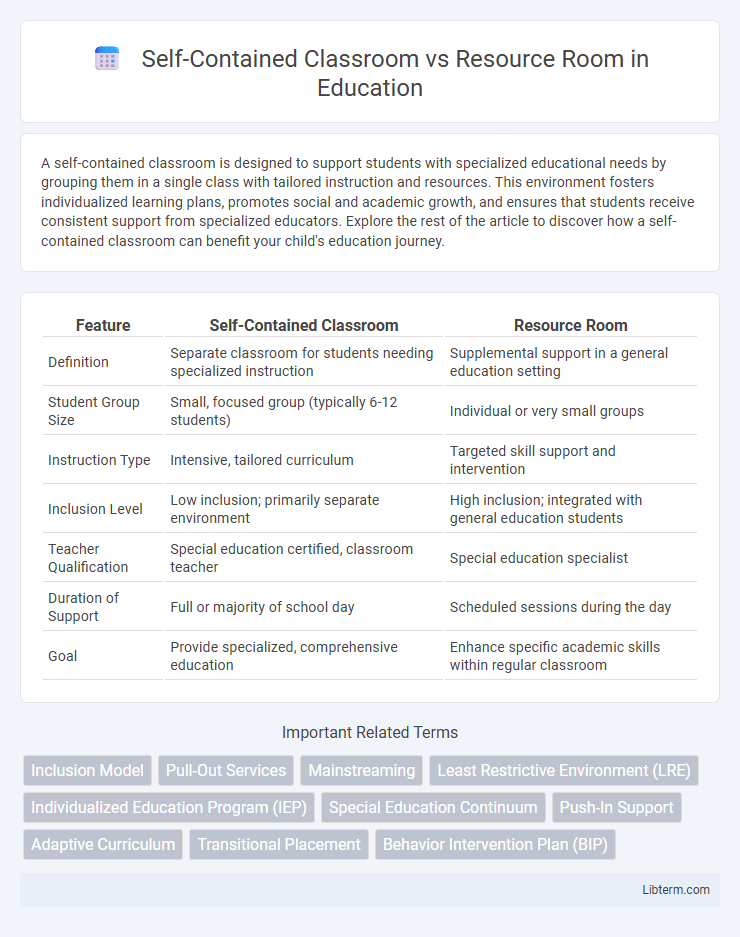A self-contained classroom is designed to support students with specialized educational needs by grouping them in a single class with tailored instruction and resources. This environment fosters individualized learning plans, promotes social and academic growth, and ensures that students receive consistent support from specialized educators. Explore the rest of the article to discover how a self-contained classroom can benefit your child's education journey.
Table of Comparison
| Feature | Self-Contained Classroom | Resource Room |
|---|---|---|
| Definition | Separate classroom for students needing specialized instruction | Supplemental support in a general education setting |
| Student Group Size | Small, focused group (typically 6-12 students) | Individual or very small groups |
| Instruction Type | Intensive, tailored curriculum | Targeted skill support and intervention |
| Inclusion Level | Low inclusion; primarily separate environment | High inclusion; integrated with general education students |
| Teacher Qualification | Special education certified, classroom teacher | Special education specialist |
| Duration of Support | Full or majority of school day | Scheduled sessions during the day |
| Goal | Provide specialized, comprehensive education | Enhance specific academic skills within regular classroom |
Introduction to Self-Contained Classrooms and Resource Rooms
Self-contained classrooms provide a structured environment where students with special needs receive intensive, individualized instruction throughout the day. Resource rooms offer targeted, supplementary support, allowing students to access core curriculum in a general education setting while benefiting from specialized teaching. Both models aim to enhance academic achievement and social skills by tailoring educational services to student needs.
Defining Self-Contained Classrooms
Self-contained classrooms are specialized educational settings where students with disabilities receive tailored instruction from special education teachers throughout the school day. These classrooms typically serve students with moderate to severe disabilities, providing individualized support and specialized curricula to address their unique learning needs. Placement in self-contained classrooms aims to maximize accessibility and promote skill development within a highly structured environment.
Understanding the Resource Room Model
The resource room model provides targeted academic support to students with learning disabilities while allowing them to remain in general education classrooms for most of the day. It focuses on delivering specialized instruction in specific subjects or skills, fostering skill development and gradual independence. This model contrasts with the self-contained classroom, where students spend the entire day in a separate, specialized setting designed for intensive support.
Key Differences Between Self-Contained and Resource Room Settings
Self-contained classrooms serve students with more intensive special education needs, offering individualized instruction within a separate, specialized environment. Resource rooms provide targeted support for students who spend most of their day in general education classrooms but require supplemental assistance in specific subjects or skills. The key difference lies in the intensity and setting of services, with self-contained classrooms emphasizing a comprehensive, separate approach, while resource rooms function as pull-out support within the mainstream school environment.
Benefits of Self-Contained Classrooms for Students
Self-contained classrooms provide an individualized learning environment tailored to students with diverse educational needs, promoting focused instruction and consistent support. These settings foster social development by grouping peers with similar challenges, enhancing collaboration and reducing distractions. Access to specialized resources and trained educators in self-contained classrooms improves academic outcomes and emotional well-being for students requiring intensive intervention.
Advantages of Resource Room Support
Resource room support offers individualized instruction tailored to students with diverse learning needs, promoting personalized academic growth within a less restrictive environment. It facilitates targeted interventions while allowing students to engage with their general education peers, enhancing social integration and access to the standard curriculum. This model supports flexible scheduling and collaboration with general education teachers, improving consistency and continuity in student learning.
Challenges and Limitations of Self-Contained Classrooms
Self-contained classrooms face challenges such as limited peer interaction and reduced exposure to a diverse curriculum, which can hinder social and academic development for students with special needs. The restrictive environment may also result in stigmatization and lower expectations, impacting student motivation and self-esteem. Resource rooms provide targeted support while promoting inclusion, making self-contained classrooms less effective in fostering holistic growth.
Challenges and Limitations of Resource Room Services
Resource room services often face challenges such as limited individualized attention due to shared spaces and restricted session durations, which can hinder tailored instruction for students with diverse learning needs. The separation from mainstream classrooms may impact social integration and limit exposure to grade-level content, affecting academic progress. Furthermore, inconsistent collaboration between resource room educators and general classroom teachers can result in gaps in communication and continuity of support.
Choosing the Right Placement: Factors to Consider
Choosing the right placement between a self-contained classroom and a resource room depends on the student's individual educational needs, social skills, and level of independence. Self-contained classrooms provide intensive support and structured settings for students with significant disabilities, while resource rooms offer targeted assistance within a general education environment. Key factors include the student's ability to access the general curriculum, social integration goals, and the intensity of specialized instruction required.
Conclusion: Finding the Best Fit for Student Success
Selecting the optimal educational setting between a self-contained classroom and a resource room hinges on each student's unique learning needs, behavioral characteristics, and academic goals. Self-contained classrooms provide intensive, individualized support within a structured environment, ideal for students requiring comprehensive assistance. Resource rooms offer targeted interventions that enhance mainstream classroom learning, benefiting students who need supplemental help while maintaining general education inclusion.
Self-Contained Classroom Infographic

 libterm.com
libterm.com